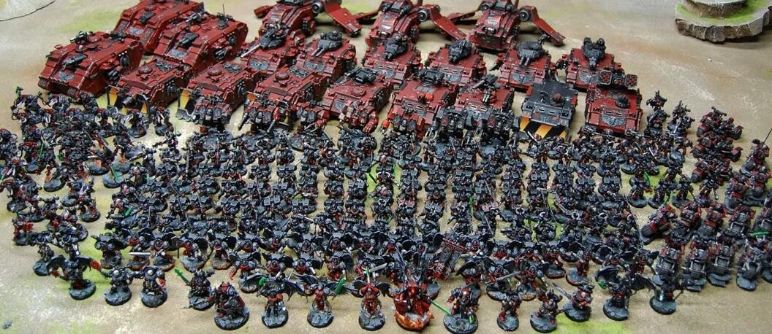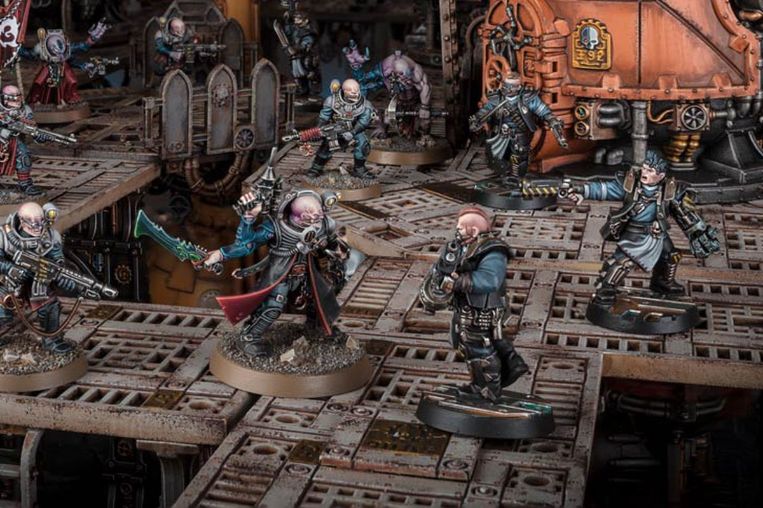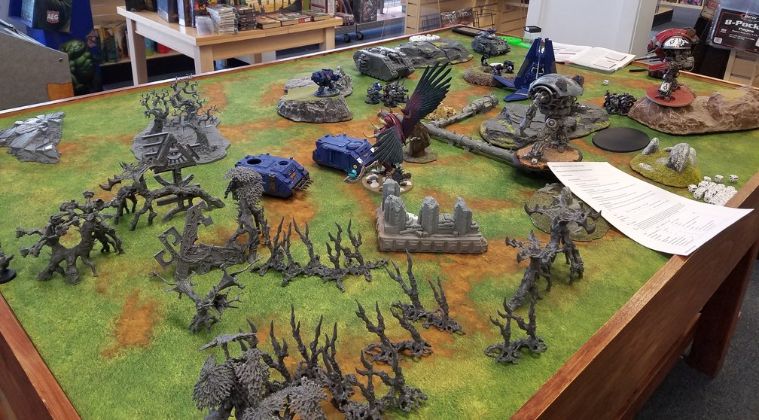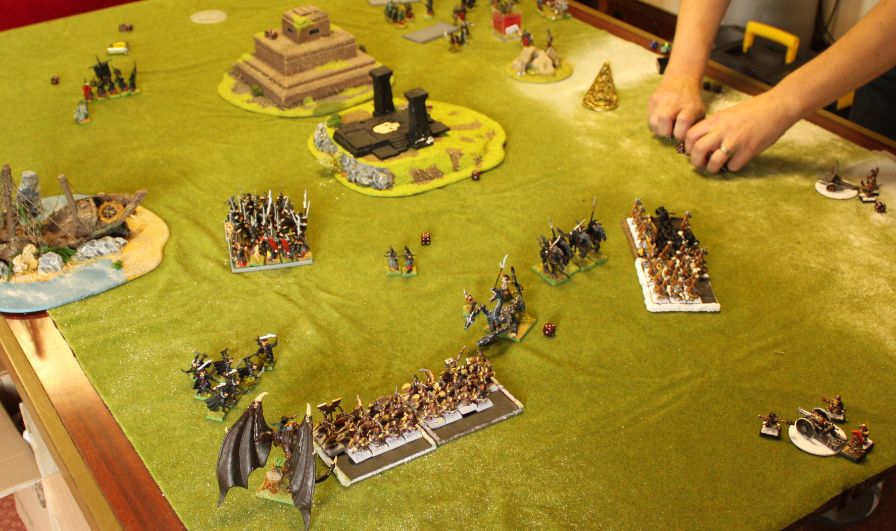Fundamentally, Warhammer 40,000 is all about fighting. There is constant, unknowable warfare. Its tagline is “In the grim darkness of the future, there is only war,” which is very economic scene-setting: you engage with the game and its rich fiction by enacting miniature war on your tabletop. Furthermore, it’s a ton of fun.
We’ll explain the Warhammer 40,000 board game’s rules in this article.
How Do You Play Warhammer 40,000?
In the tabletop wargame Warhammer 40,000, you engage in combat using miniatures that are best when they have been built and painted by you.
Currently, in its eighth edition, it is a much more streamlined game than it once was. It is based around playing fairly quick objective-based matches that involve throwing a lot of dice, estimating distances, and using the specific rules of your faction to implement synergies and tactics to defeat your opponent.
A force, consisting of a few units or a sizable army, will oppose you in battle. You choose which units to move, use psychic abilities on, fire from your gunline, and then charge and attack in a given turn.
To measure distances and success, you’ll use dice and rulers. You will only be able to use a finite number of command points in each game to implement game-changing stratagems that will increase the efficiency of your units at crucial moments.

Although many will argue that Warhammer 40,000 comes alive as a competitive game, Games Workshop tries to support both Open and Narrative play. However, in my experience, the sweet spot exists somewhere between competitive and Narrative and finding good opponents who match your enthusiasm and expectations is essential.
Open is as it suggests: an opportunity to put anything on the table, dropping and adding rules as you and your opponent see fit. In the narrative, balance is sacrificed in favor of the cinematic bombast of hopeless sieges and thrilling infiltrations. However, the narrative focuses on quasi-historical battles based on fiction.
Every year, Games Workshop updates its points for matched play and analyzes them in a supplement called Chapter Approved that also modifies the rules for different armies.
How to Build An Army in Warhammer 40,000?
The Warhammer 40,000 App
Before we get into army building, it’s worth noting that Warhammer 40,000 has an army-building app available on iOS/Android. You can build your army in the app for a small subscription fee (it has recently been reduced), and the app will keep track of what you need to add to your army to make it playable.
Even though the app has many options for building different detachments and adding equipment, you must still purchase the codexes for each army to access its complete set of rules. The most recent version of the game’s physical codex books is each equipped with a code that can be used to access the book’s contents via an app.

The Warhammer 40,000 app still makes it much simpler for a beginner to understand how to build an army for the game, even though it is significantly less useful than, say, the Warhammer Age of Sigmar app where you can actually buy the rulebooks within the app.
So, even though it still has a long way to go before it is perfect, this guide suggests that you download the app in order to build an army. Just be aware that you shouldn’t anticipate the app to contain all the rules you require to complete the game (although that would be awesome). Hey, maybe someday.
Datasheets
The basic rules of each unit in the game can be found on their datasheet, which is a small block of rules and statistics. Despite being small, it does have a lot of information. In this section, we go over all the aspects of a datasheet by looking at the datasheet for Severina Raine, a hero of the Imperium, which is available to download for free at the Warhammer Community website:
The battlefield role of each unit is indicated by a symbol in the top left corner, which is crucial if you’re creating an army for matched play. The Power Level of that is next (a cost), and we’ll talk more about that in the paragraph that follows this one.
Then we have the unit’s statistics, which are lined up horizontally:
- M is Move: How much space your unit can occupy during a turn. It’s noted in inches.
- WS is Weapon Skill: How easily your model can hit another model in close combat. If you roll three or more on a six-sided die to hit your adversary, you get a three or more, or a three plus.
- BS is A model’s ability to hit another model with a ranged weapon is referred to as ballistics skill. This is also a 3+, so in order to hit, you must roll a 3 or higher.
- S is Strength: By comparing it to the enemy model’s Toughness, Strength is used to determine what you must roll to wound an enemy model. It will be simpler and more difficult to wound an enemy model if your Strength is higher than their Toughness. This article covers that system in the “Rolling Dice” section further below.
- T is Toughness: When compared to the enemy model’s Strength, toughness determines how many wounds the enemy model must receive.
- W is How many wounds can your model sustain before it expires?
- A is The number of attacks your model can make in a single round of close combat.
- Ld is Leadership: it is used to determine the morale of the model, which we also cover in the rules section below
- Sv is Save: If you roll a higher number than this, you can attempt to block the damage that an enemy will deal to you. However, there are some forms of damage that you cannot save against.
What is Warhammer?

Using armies of brave humans, noble elves, savage orcs, or a variety of twisted and monstrous creatures, players command armies in the tabletop wargame Warhammer. Players assemble armies of tiny plastic models, each with a unique set of stats and skills, and use them to reenact battles on a miniature battlefield.
In contrast to a board game, where players’ movements are limited to specific spaces, Warhammer commanders can freely move their units while setting distances with rulers and deciding on shooting and hand-to-hand combat with dice.
The game has undergone several iterations over the course of its existence, with rules changes and the addition of new units and creatures for players to use in their armies. With its armies of Space Marines, war machines, and ruthless alien hordes, its science fiction offshoot, Warhammer 40,000, has proven to be phenomenally popular.
You’re likely to find sizable Warhammer battlegrounds set up inside a Games Workshop store, usually exquisitely detailed to resemble real landscapes.
How Do I Get Started, and What Does It Cost?
Everything you need to engage in quick two-player battles between the Stormcast Eternals and the forces of Chaos is included in the Age of Sigmar starter set. The cost of entry is significantly less than the price of a gaming PC or current-gen games console, but at £75 ($125 in the US, $200 in Australia), it’s not cheap.
Since the game’s miniatures are unassembled and unpainted when you first start playing, you’ll also need to buy some modeling supplies, paints, and brushes. If all of this seems a little intimidating, you can find many online tutorials that cover army painting techniques.
Even if you’re not Michaelangelo, most adversaries will anticipate that you will at least give your troops a simple coat of paint.
You’ll also need opponents to play against, while we’re on the subject. Over 400 Games Workshop locations exist worldwide and host events. Find a local games club to play at instead if you prefer. Numerous people plan casual competitions or more serious games.
Read More:
